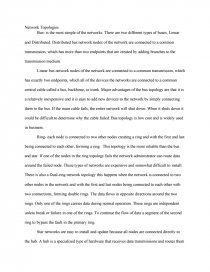Network Topologies
Essay by review • February 17, 2011 • Essay • 420 Words (2 Pages) • 1,097 Views
Network Topologies
Bus- is the most simple of the networks. There are two different types of buses, Linear and Distributed. Distributed bus network nodes of the network are connected to a common transmission, which has more than two endpoints that are created by adding branches to the transmission medium.
Linear bus network nodes of the network are connected to a common transmission, which has exactly two endpoints, which all of the devices the networks are connected to a common central cable called a bus, backbone, or trunk. Major advantages of the bus topology are that it is a relatively inexpensive and it is easy to add new devices to the network by simply connecting them to the bus. If the main cable fails, the entire network will shut down. When it shuts down it could be difficult to determine why the cable failed. Bus topology is low cost and is widely used in business.
Ring- each node is connected to two other nodes creating a ring and with the first and last being connected to each other, forming a ring. This topology is the more reliable than the bus and star. If one of the nodes in the ring topology fails the network administrator can route data around the failed node. These types of networks are expensive and somewhat difficult to install. There is also a Dual-ring network topology this happens when the network is connected to two other nodes in the network and with the first and last nodes being connected to each other with two connections, forming double rings. The data flows in opposite directions around the two rings. Only one of the rings carries data during normal operation. These rings are independent unless break or failure in one of the rings. To continue the flow of data a segment of the second ring to bypass the fault in the primary ring.
Star networks are easy to install and update because all nodes are connected directly to the hub. A hub is a specialized type of hardware that receives data transmissions and routes them to the proper destination. When a business needs to reconfigure its network, it makes changes to the hub instead of completely rewiring the network. When a problem arises with a node it is easier to find the problem in this node. The hub can also bottleneck and slow down the network. The main disadvantage of this topology is the if the central hub fails there will be no transmission at any node.
...
...

